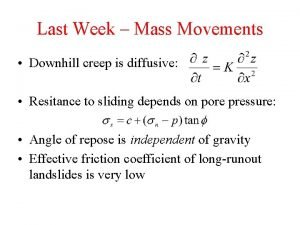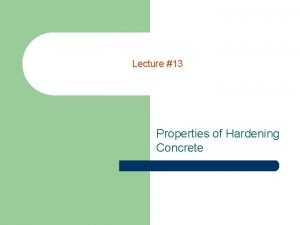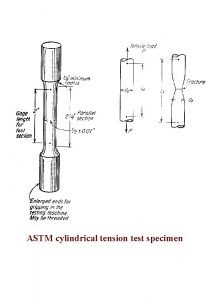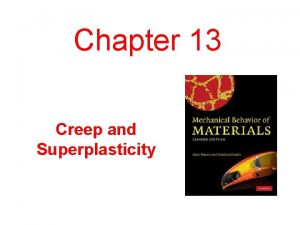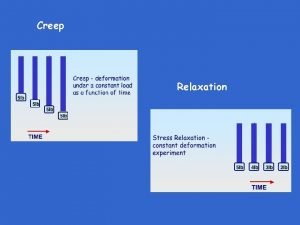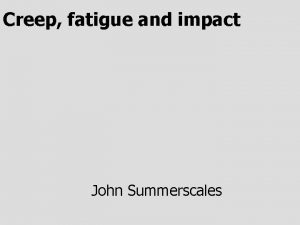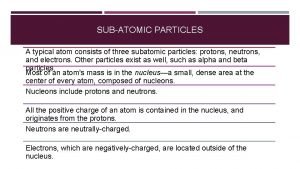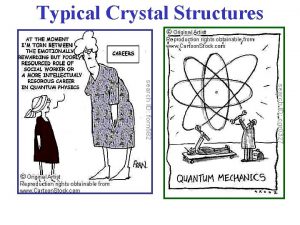Creep Test A typical creep test consists of









- Slides: 9

Creep Test A typical creep test consists of subjecting a specimen to a constant load or stress while maintaining the temperature constant ( > o. 4 Tm) ; deformation or strain is measured and plotted as a function of elapsed time as illustrated in figure 2. Figure 1 creep test set-up For metallic materials most creep tests are conducted in uniaxial tension using a specimen having the same geometry as for tensile tests.

Fig (2) Typical creep curve of strain versus time at constant stress and constant elevated temperature

Creep Stages: Following the instantaneous deformation (elastic region), there are three stages: 1 -Primary Creep: starts at a rapid rate as a result of dislocations movements and slows with time due to the work hardening (low temperature) which ties-up the dislocations at grain boundaries. 2 - Secondary Creep: has a relatively uniform strain rate due to the balance between work hardening and annealing (thermal softening). This is often the stage of creep that is of the longest duration 3 - Tertiary Creep: has an accelerated creep rate and terminates when the material breaks or ruptures. This acceleration due to with the formation of voids and micro-cracks at grain boundaries.

Cavitation Phenomenon: - In tertiary region, rupture occurs due to the pore formation (cavitation) at grain boundaries. - Cavities form on grain boundaries that are perpendicular to the applied force - Eliminating the grain boundaries altogether should enhance the creep-rupture life - This was the motivation for developing single crystal alloys. Figure -3 - Cavity coalescence at grain boundaries

Design Parameters Most important design parameters in creep are: • Measure Steady state creep rate • Measure Rupture life time tr (stress rupture test). Similar to creep test except the stress is higher Note: both of designs strongly depend on temperature and stress applied Creep Test. Stress Rupture Test Measures strain versus time at constant temperature and load or stress Measures stress versus time to rupture at constant temperature Relatively low loads and creep rates. Higher loads and creep rates Long duration, 2, 000 to 10, 000 hours. Not always to fracture . . Shorter duration, less than 1, 000 hours typically. Always to fracture Strain measured accurately using sensitive equipment (inductance gauges) to determine creep rate. Strains typically less than 0. 5%. Simpler less sensitive strain measuring equipment (dial gauges). Time and strain to fracture measured. Strains typically up to 50%.

Fig (3): Effect of temperature and stress on creep behavior

Data extrapolation method One of the most popularly used techniques in representing creep-rupture data is Larson-Miller Time –temperature parameters. This parameter can be derived from the stress and temperature dependence of the creep rate or time to rupture. The rate equation generally can be written in the form of the Arrhenius equation and expressed as PLM= T [C + log (tr)] where C is a constant (usually on the order of 20), for T in Kelvin and the rupture lifetime in hours, P LM is Larson-Miller parameter. Example: Using the Larson–Miller data for S-590 iron shown in Figure 4, predict the time to rupture for a component that is subjected to a stress of 140 MPa at 800 C Solution From Figure 4 , at 140 MPa the value of the Larson–Miller parameter is 24 x 103 , for T in K and in h; therefore, 24 x 103 = T [C + log (tr)] 24 x 103 = ( 800+273) [ 20+ log (tr)] 20+ log (tr) = 22. 37 tr= 233 hour (9. 7 days).

Figure -4 - Logarithm stress versus the Larson–Miller parameter for an S-590 iron.

Design Considerations to avoid Creep • Reduce the effect of grain boundaries: • Use single crystal material with large grains. • Addition of solid solutions to eliminate vacancies. • Employ materials of high melting temperatures. .

